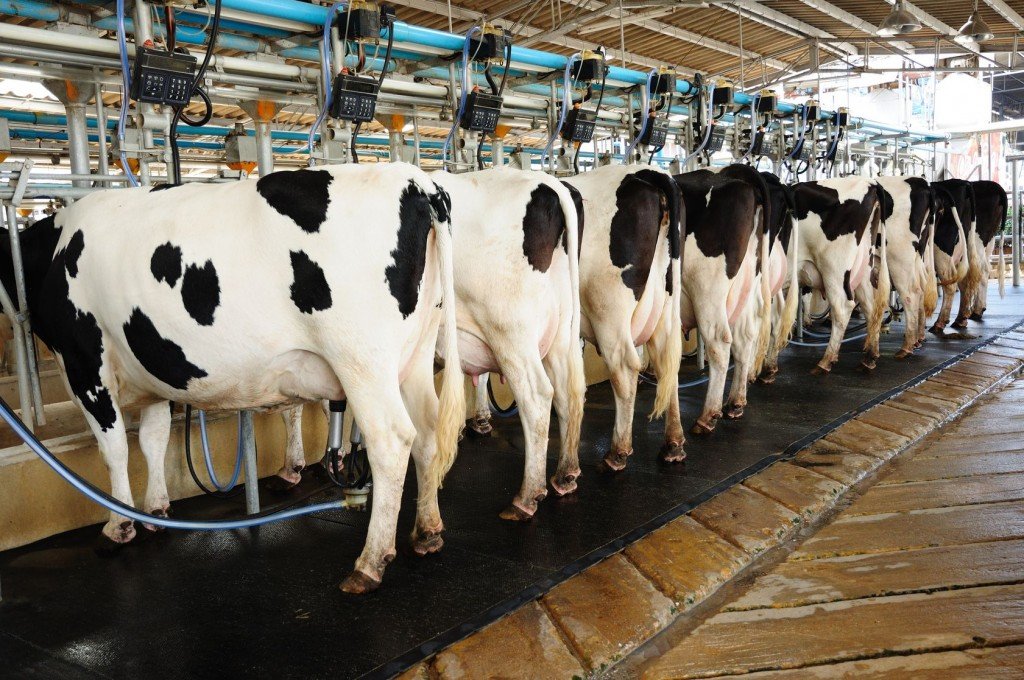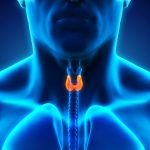Jacqueline Carboni, NMD
Like all biological molecules, hormones are dependent on enzymes and their vitamin and mineral cofactors for activation and synthesis, and are often modified or regulated within conjugation pathways in the liver. Unfortunately, with modern technology has come the destruction of most enzymes and vitamins in food and liquids, particularly milk, which are subject to the high temperatures of pasteurization methods.
Hormone research has been the lure of private enterprise to make products faster, bigger and to have a longer shelf-life. Often, label information has been suppressed and inadequate research has been overlooked by lax FDA officials since the approval of recombinant bovine somatotropin (rBST), or recombinant bovine growth hormone (rBGH). Since the 1950s, a handful of dairy corporations have succeeded in monopolizing the dairy industry, with increasing inhumane handling of their livestock. The FDA approved rBST in 1993 and as of 1999, rBST was in use in 30% of the dairy industry (Fetrow, 1999). However due to consumer pressure, a U.S. Department of Agriculture survey in 2007 determined that only about 15% of dairy farms used rBST and 17% of cows were injected. That’s down from 22% of cows in 2002. Large farms are far more likely to use rBST than small farms (Fox, 2008). A list of statewide dairy farms not using rBST is available online (www.sierraclub.org/biotech/NonrBGH.asp).
While rBST is a serious threat, other hormones are used during growth and development in factory farm animals. Two-thirds of American beef cattle raised today are injected with hormones. Serious health concerns associated with hormonal compounds used as growth promotants are their carcinogenic and endocrine-disrupting potentials. Some of the hormones of concern that are used in cattle are the natural hormones estradiol, progesterone and testosterone, and the synthetic hormones zeranol, trenbolone acetate and melengestrol acetate (Chemical Review, 2003).
Confined Animal Feeding Operations
A large Confined Animal Feeding Operation (CAFO) for dairy comprises up to 700 cows crammed in stalls with their tails cut off. They stand in their manure, which is captured underneath or in open-air lagoons where it is held as a liquid manure system and which creates excessive air, water and soil pollution. Toxic waste containing antibiotics, hormones and other chemicals concentrate in these lagoons. Leachate of pesticides, antibiotics, hormones and nitrogenous compounds pollute the groundwater and end up in human water supply for consumption and agricultural irrigation. Hormonally sensitive aquatic life is poisoned by runoff, which pollutes rivers, lakes and oceans.
Methane gas produced by the degradation of waste is 20 times more powerful a greenhouse gas than CO2 (US EPA, 2007). This unsustainable human activity and indiscriminate pharmacological dosing of genetically-engineered hormone (rBST); hormonally active agents, including approved drugs for cows and pesticide- and herbicide-laden feed; and prophylactic use of antibiotics has impacted the hormone integrity and balance in all living species. Far-reaching effects of irreparable damage that have contributed substantially to both environmental and healthcare costs have outweighed the excuses of their economic efficiency in mass food production (Horrigan, 2002).
Industrial agriculture and animal husbandry have produced food products from plants and livestock that contain limited biodiversity and are fraught with chemicals and genetically-engineered proteins and hormones. Among factory-farmed livestock, few breeds dominate the bovine, sheep and pig herds. CAFOs are the source of breeds of animals that are chronically ill and administered continuous low doses of antibiotics and hormones to accelerate growth. Dairy cows are injected with genetically engineered growth hormone to increase milk production; never pastured; fed the cheapest grains, animal waste products and toxic metals to accelerate weight gain; and raised in crowded conditions where they stand in their waste (Li et al., 2005; www.sustainabletable.org).
Pharmacological use of somatostatin increases milk supply 10%-20% at the cost of shortened lifespan, hoof disease, open sores and internal bleeding for the livestock. Due to excessive milk production, the lactating cows become malnourished and their painfully swollen and bleeding udders readily become infected. The milk produced can be laced with bacteria and blood.
Unhealthy Livestock, Unhealthy People
As a clinician and educator, my interest in the impact on obesity, cardiovascular disease and cancer has stimulated my research into these conditions and their relationship with the use of dairy foods.
What I have found is a compelling correlation between unhealthy cows and unhealthy people. In my naturopathic studies, food allergies, lectins (Cordain et al., 2000) and lack of lactose enzyme have been assigned as the major culprits associated with excess insulin production and gluconeogenic stress hormone activity, resulting in inflammation and fat accumulation. Although justified, the ordinary components of milk cannot be the only cause.
A closer look at the hormonal impact will corroborate my findings.
Dairy food production over the past century has led to widespread environmental damage. Mass-produced milk has been depleted of essential fatty acids, contains excess amounts of cholesterol and saturated fats, residues of antibiotics, artificial growth hormone and IGF, and hormonally active agents from agricultural industry (Haapapuro, 1997).
The use of breeding, feeding inputs and new technology has led to a quadrupling of the average amount of milk produced per dairy cow between 1950 and 2005. The presence of higher levels of growth hormone and IGF in food consumed on a regular basis has far-reaching effects in humans.
Growth hormone activity has direct effects on target cells. Adipocytes have growth hormone receptors that when stimulated promote the breakdown of triglyercerides and suppress the uptake of circulating lipids. The indirect effect of growth hormone is the response of the liver and other tissues to make IGF.
Long-term effects of exposure to growth hormone induces an increased sensitivity of adipocytes to insulin (Lonnroth et al., 1987). Growth hormone and IGF are increased in milk of rBST-injected cows (Hansen, 1997).
In addition, the increase in stature among recent generations of children, along with early menstruation and the correlation with increased risk of breast cancer, are the result of increased exposure to growth hormone, IGF and other trophic hormones from meat and dairy consumption (Uauy and Solomons, 2005).
Prolonged dosing of growth hormone appears to have an opposite effect on lipolysis by its effect on receptor sites for IGF. It has been demonstrated that prolonged exposure to growth hormone and IGF downregulates the sensitivity to insulin, subsequently causing the cell to produce daughter cells with increased numbers of receptor sites and thereby increasing both the uptake of glucose and fat synthesis (Lonnroth et al., 1987).
IGF and insulin are equivalent in their potency to promote the uptake of glucose by fat cells and stimulate production of adipocytes. IGF is a potent regulator of clonal expansion in 3T3-L1 preadipocytes (Siddals et al., 2002).
Adipocytes are endocrine cells that secrete a broad range of hormones, cytokines and growth factors involved in cell turnover and inflammation. The impact of chronic and increased levels of growth hormone and IGF has been demonstrated in vascular diseases from atherosclerosis, hypertension and diabetes to angiogenesis in cancer (Delafontaine et al., 2004; Chan et al., 1998; Baur et al., 2006).
Milk from cows given rBST to stimulate milk production is more immunogenic by virtue of the difference of one N-terminal amino acid on the modified growth hormone (Erhard et al., 1994). In addition, rBST-treated cows have increased IGF-1 concentrations up to double that of non-treated cows (Hansen et al., 1997).
These hormones survive pasteurization and digestive acids and enzymes in humans. In fact, the FDA admitted that BGH-treated milk does not get destroyed during pasteurization, but actually increases in concentration (Prosser, 1988, 1989; Mepham, 1992). A Harvard Medical School cross-sectional study of 1037 healthy women published in 2002 found that the association of higher dairy intake with higher IGF-1 levels was particularly consistent. These results raise the possibility that milk consumption could influence the risk of cancer by a mechanism involving IGF-1. Additionally, positive associations between milk intake and risk of prostate cancer have been reported (Holmes et al., 2002).
Studies have shown that calorie-restricted diets high in calcium induce liploysis and maintain thermogenic effects, which fosters acceleration of weight loss. There is evidence that vitamin D-fortified milk may have an opposite effect. Increased levels of active vitamin D, calcitriol, have the direct effect of an increased influx of calcium into the adipose cells, which stimulates adipose cell size and fat accumulation by lipolysis suppression (Zemel, 2003).
Fatty Acids, CLA and Vitamins
What is missing in milk from CAFO is just as important as what is in it.
Milk from pasture-fed cows contains more fatty acid content than factory-farmed cows, and steak from grass-fed cattle is almost always lower in total fat and higher in fatty acids (Clancy, 2006). A close look at milk labels reveals an interesting incrimination to commercial milk products and even milk products from cows fed organic grains. The 9g of fat content in whole milk from conventional and organic grain-fed cows contains 100% saturated fat and 35mg of cholesterol per 8 ounces, which equals 50% of the caloric value per serving. Compare this to milk labels of grass-fed, pastured cows: 9g total fat content, but only 5g saturated fat and 20-30mg of cholesterol, providing 27% saturated fat per 8oz serving.
Those four grams of unsaturated fat are a combination of omega-6 and -3 fatty acids, with a ratio of 2:1 per serving. The conjugated linoleic acid (CLA) portion of the omega-6 ratio of unsaturated essential fatty acid content varies with the time of year and percentage of grass and silage fed to the cows. Pastured cows receive silage that is fermented hay during winter, when grass feeding is not available. Milk produced by grass-fed cows in season has the highest CLA content (Jahreis et al., 1997).
Milk from pastured cows that are 100% grass fed contains elevated amounts of vitamins A and E, CLA and an omega-6 to -3 ratio of 2:1 and 1:1, which is most biologically favorable for preventing cancer and heart disease (Daley et al., 2006; Dhiman et al., 1996). One study’s results indicated that consumption of CLA reduces body fat mass in overweight and moderately obese healthy persons (Blankson et al., 2000).
Omega-3 fatty acids reduce the risk of heart disease, hypertension, arrhythmias and heart attack (Siscovick et al., 1995), and are essential in helping to reduce the risk of Alzheimer’s, attention deficit disorder, schizophrenia and depression (Perlmutter, 2004). Simply allowing cows to pasture feed naturally increases the omega-3 content (Mandell et al., 1998).
Vitamin A is an essential fat-soluble vitamin important for normal vision, including clarity of the lens and stimulation of rods for night vision. It also plays an essential role in reproduction, cell division and cell differentiation. Vitamin A promotes healthy surface linings of the eyes and the respiratory, urinary, and intestinal tracts, thereby creating a healthy barrier against bacteria and viruses. Another role of vitamin A is in immunity by supporting the production and function of neutrophils and lymphocytes.
In addition to being higher in omega-3s, CLA, and beta-carotene, grass fed beef is much higher in vitamin E. The health benefits of vitamin E have been linked to lower risk of heart disease and cancer and anti-aging. The reason for the high vitamin E content in the meat of grass fed cattle is the high content in fresh grass. Plasma concentrations of vitamin E in cows are inversely correlated when yield is increased (Soren et al., 1999). Stress may cause a reduction in α-tocopherol values in cattle (Nockels et al., 1996).
In my practice, I have found that appropriate amounts of meat, eggs and milk products made from healthy animals that are grass fed along with a high-fiber diet with sufficient quantities of yellow root and ground vegetables, leafy greens and fruits, fresh air, adequate sunlight, good water and proper exercise alleviate much of the cognitive, digestive and inflammatory problems that go hand in hand with major chronic diseases of today, including heart disease, cancer, autoimmune disorders, anxiety and depression (Cordain et al., 2006).
Jacqueline Carboni, NMD utilizes the state of the art in integrating ancient healing practices of oriental medicine with advances in science and evidence-based naturopathic medicine. This is accomplished through her formal training and education from accredited schools and clinical experience for more than 35 years. She is a 1998 graduate of SCNM and Health Sciences. Advanced Chinese Medicine training was completed at The Phoenix Institute of Herbal Medicine and Acupuncture. She currently is an adjunct professor in the natural science division at Mercy College in New York.
References
Blankson H et al: Conjugated linoleic acid reduces body fat mass in overweight and obese humans, J Nutr 130:2943-48, 2000.
Baur JA et al: Resveratrol improves health and survival of mice on a high-calorie diet, Nature 4444:337-342, 2006.
California State Senate: “Confined Animal Facilities in California,” state of California, November 2004.
Chan JM et al: Plasma insulin-like growth factor-1 and prostate cancer risk; a prospective study, Sci 279(5350):563-6, 1998.
Clancy K: Greener pastures: how grass-fed beef and milk contribute to healthy eating (executive summary), Un Concerned Sci Mar, 2006.
Cordain L: Implications of plio-pleistocene hominin diets for modern humans. In: Early Hominin Diets: The Known, The Unknown, and The Unknowable, Ungar, P (Ed.), Oxford University Press, Oxford, 2006, pp 363-83.
Cordain L et al: Modulation of immune function by dietary lectins in rheumatoid arthritis, Brit J Nutr 83:207-217, 2000.
Chemical Review and International Harmonisation: A review to update Australia’s position on the human safety of residues of hormone growth promotants (HGPs) used in cattle, Office of Chemical Safety, Therapeutic Goods Administration of Department of Health and Ageing, Canberra, July 2003.
Daley et al: Literature review of the value-added nutrients found in grass-fed beef products, Nutrition Journal June, 2006.
Delafontaine P et al: Expression, regulation, and function of IGF-1, IGF-IR, and IGF-1 binding proteins in blood vessels, Arterioscl, Thrombos and Vasc Biol 435-444, 2004.
Dhiman TR: Factors affecting conjugated linoleic acid content in milk and meat, Critical Reviews in Food Science and Nutrition 45:463-82, 2005.
Dhiman TR et al: Conjugated linoleic acid content of milk from cows fed different diets, J Dairy Sci Oct;82(10):2146-56, 1999.
Dietary Guidelines Advisory Committee, Agricultural Research Service, United States Department of Agriculture (USDA): Report of the Dietary Guidelines Advisory Committee on the Dietary Guidelines for Americans, 2000. Available from www.ars.usda.gov/dgac.
Donovan SM and Odle J: Growth factors in milk as mediators of infant development (annual review of infant development), Annual Review of Nutrition 14:147-67, 1994.
Erhard MH et al: Identification of antigenic differences of recombinant and pituitary bovine growth hormone using monoclonal antibodies, J Immunoassay 15(1):1-19, 1994.
Fetrow J: Economics of recombinant bovine somatotropin on US dairy farms, AgBioForum 2(2):103-110, 1999. Available from www.agbioforum.org.
Fox C. Got rBST-Free Milk? GreenRightNow Web site. http://www.greenrightnow.com/2008/02/28/got-rbst-free-milk. Published February 28, 2008. Accessed June 16, 2008.
Gerster H: Vitamin A–functions, dietary requirements and safety in humans, Int J Vitam Nutri Res 67:71-90, 1997.
Haapapuro ER et al: Review – animal waste used as livestock feed: dangers to human health, Prev Med 26(5)Pt1:599-602, 1997.
Hansen M et al: Potential public health impacts of the use of recombinant bovine somatotropin in dairy production, Sci Rev Joint Expert Comm Food Add 1997.
Harbige LS: Nutrition and immunity with emphasis on infection and autoimmune disease, Nutri Health 10:285-312, 1996.
Holmes MD et al: Dietary correlates of plasma insulin-like growth factor I and insulin-like growth factor binding protein 3 concentrations, Cancer Epidemiol Biomarkers Prev Sep;11(9):852-61, 2002.
Horrigan L et al: How sustainable agriculture can address environmental and human health harms of industrial agriculture, Environ Health Perspect 110(5):445-456, 2002.
Jahreis G et al: Conjugated linoleic acid in milk fat: high variation depending on production system. Nutrition Research 17(9):1479-1484, 1997.
Kang K et al: Trans-10,cis-12 CLA inhibits differentiation of 3T3-L1 adipocytes and decreases PPAR gamma expression, Biochem Biophys Res Commun Apr 11;303(3):795-9, 2003.
Kang K et al: Evidence that the anti-obesity effect of conjugated linoleic acid is independent of effects on stearoyl-CoA desaturase1 expression and enzyme activity, Biochem Biophys Res Commun Mar 12;315(3):532-7, 2004.
Li G et al: NF-kappaB independent inhibition of lipopolysaccharide-induced cyclooxygenase by a conjugated linoleic acid cognate, conjugated nonadecadienoic acid, Biochim Biophys Acta Sep;1761(9):969-72, 2006.
Li Y et al: A Survey of Selected Heavy Metal Concentrations in Wisconsin Dairy Feeds, J Dairy Sci 88:2911–292, 2005.
Lonnroth P et al: Regulation of insulin-like growth factor II receptors by growth hormone and insulin in rat adipocytes, Proceed Nat Acad Sci Ju1(84)11:3619-3622, 1987.
Mandell IB et al: Enrichment of beef with omega 3 fatty acids, World Rev Nutr Diet 83:144-59, 1998.
Mepham TB: Public health implications of Bovine somatotropin use in dairying: discussion paper, J Royal Soc Medicine 85:736-739, 1992.
Nockels CF et al: Vitamin E supplementation and stress affect tissue alpha-tocopherol content of beef heifers, J Anim Sci 74(3):672-677, 1996.
Park Y et al: Structure-activity relationship of conjugated linoleic acid and its cognates in inhibiting heparin-releasable lipoprotein lipase and glycerol release from fully differentiated 3T3-L1 adipocytes, J Nutr Biochem Sep;15(9):561-8, 2004.
Perlmutter D: The Better Brain Book, New York, 2004, Penguin Books, p. 64.
Prosser CG: Bovine somatotropin and milk composition, The Lancet Nov 19:1201, 1988.
Prosser CG et al: Increased secretion of insulin-like growth factor 1 into milk of cows treated with recombinantly derived bovine growth hormone, J Dairy Res 56:17-26, 1989.
Robinson J: Why Grass-Fed is Best: The Surprising Benefits of Grass-Fed Meat, Eggs, and Dairy Products, Vashion, 2000, Vashion Island Press, p. 43.
Siddals KW et al: IGF-binding protein-1 inhibits IGF effects on adipocyte function: implications for insulin-like actions at the adipocyte, J Endocrin 289-297, 2002.
Siscovick DS et al: Dietary intake and cell membrane levels of long-chain n-3 polyunsaturated fatty acids and the risk of primary cardiac arrest, JAMA 274(17):1363-1367, 1995.
Soren KJ et al: Quantitative secretion and maximal secretion capacity of retinol, (beta)-carotene and (alpha)-tocopherol into cows’ milk, Journal of Dairy Research 66(4):511-522, 1999.
Sustainable Agriculture Research and Education (SARE): Pastured Poultry Products: Summary, Washington DC, 1999, SARE.
Uauy R and Solomons N: Diet, nutrition, and the life course approach to cancer prevention, J Nutr Dec 135:2934S-2935S, 2005.
Zemel MB: Mechanisms of dairy modulation of adiposity, J Nutr Jan;133(1):252S-256S, 2003. Review.
U.S. Environmental Protection Agency Web site. http://www.epa.gov/methane. Updated April 27, 2007. Accessed June 16, 2008.
Washington state Dept. of agriculture. Animal proteins prohibited in ruminant feed: http://agr.wa.gov/FoodAnimal/AnimalFeed/Publications/ProhibMatDefs.pdf
Center for Food Safety. Mad cow disease: closing the loopholes in FDA’s feed regulations: www.centerforfoodsafety.org/pubs/FDAFeedRuleFactSheetJan2004.pdf
University of Wisconsin Dept. of Nutritional Sciences. Michael W. Pariza: www.nutrisci.wisc.edu/FACULTYPAGES/f_pariza.html
Sustainable Table: www.sustainabletable.org





